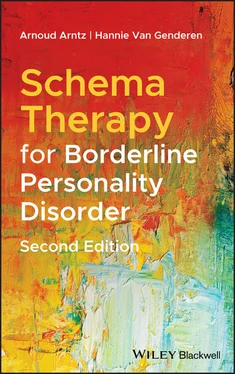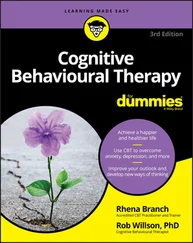Hannie van Genderen - Schema Therapy for Borderline Personality Disorder
Здесь есть возможность читать онлайн «Hannie van Genderen - Schema Therapy for Borderline Personality Disorder» — ознакомительный отрывок электронной книги совершенно бесплатно, а после прочтения отрывка купить полную версию. В некоторых случаях можно слушать аудио, скачать через торрент в формате fb2 и присутствует краткое содержание. Жанр: unrecognised, на английском языке. Описание произведения, (предисловие) а так же отзывы посетителей доступны на портале библиотеки ЛибКат.
- Название:Schema Therapy for Borderline Personality Disorder
- Автор:
- Жанр:
- Год:неизвестен
- ISBN:нет данных
- Рейтинг книги:3 / 5. Голосов: 1
-
Избранное:Добавить в избранное
- Отзывы:
-
Ваша оценка:
- 60
- 1
- 2
- 3
- 4
- 5
Schema Therapy for Borderline Personality Disorder: краткое содержание, описание и аннотация
Предлагаем к чтению аннотацию, описание, краткое содержание или предисловие (зависит от того, что написал сам автор книги «Schema Therapy for Borderline Personality Disorder»). Если вы не нашли необходимую информацию о книге — напишите в комментариях, мы постараемся отыскать её.
Shema Therapy for Borderline Personality Disorder
Schema Therapy for Borderline Personality Disorder
Schema Therapy for Borderline Personality Disorder — читать онлайн ознакомительный отрывок
Ниже представлен текст книги, разбитый по страницам. Система сохранения места последней прочитанной страницы, позволяет с удобством читать онлайн бесплатно книгу «Schema Therapy for Borderline Personality Disorder», без необходимости каждый раз заново искать на чём Вы остановились. Поставьте закладку, и сможете в любой момент перейти на страницу, на которой закончили чтение.
Интервал:
Закладка:
There have been several studies completed now on ST for BPD (see Jacob & Arntz, 2013 and Sempertegui, Karreman, Arntz, & Bekker, 2013, for reviews), including studies on group‐ST (Farrell, Shaw, & Webber, 2009), the combination of individual and group‐ST (Dickhaut & Arntz, 2014; Fassbinder et al., 2016), and inpatient ST (Reiss, Lieb, Arntz, Shaw, & Farrell, 2014). Taken together, these studies indicate low dropout from treatment and high effectiveness of ST, that is not limited to BPD‐symptom reduction, but includes better social and societal functioning, better quality of life, and increased happiness. When dropout from ST for BPD is compared to other treatments, a multilevel survival meta‐analysis indicated that the dropout percentages reported so far in ST studies are remarkably smaller than those from other treatments (Arntz et al., 2020). The effectiveness of ST on measures of BPD‐severity and specific BPD‐traits is also high and the effect sizes tend to be significantly higher than in other treatments (Rameckers et al., 2020). However, so far only one larger RCT has been published that compared ST to another treatment (Giesen‐Bloo et al., 2006). It is necessary that more RCTs compare ST to other treatments, including treatment as usual and other specialized psychotherapies. One large international study comparing the combination of individual and group‐ST, group‐ST, and (optimal) treatment as usual for BPD was just completed when this book was finalized. The preliminary results indicated that ST was superior to treatment as usual in primary and secondary outcomes, and that especially the combined individual–group format was effective and associated with the highest treatment retention (Wetzelaer et al., 2014; Arntz et al., 2019). Another study that is currently underway is a German study comparing the combination of individual and group‐ST to DBT as treatments for BPD (Fassbinder et al., 2018). Both RCTs include not only focus on effectiveness, but also study cost‐effectiveness and experiences of patients.
What makes ST so acceptable for patients and what might explain its effectiveness? Qualitative studies into the views of patients and therapists have yielded some suggestions (de Klerk, Abma, Bamelis, & Arntz, 2017; Tan et al., 2018). First, the schema mode model is often mentioned as very helpful, offering both patients and therapists an easy to understand model of the patient's problems. This offers a meta‐cognitive understanding to patients and helps therapists to choose the right technique. Second, the therapeutic relationship, more specifically limited reparenting, is mentioned as particularly helpful. Third, experiential techniques are mentioned as particularly powerful. Fourth, on a more general level, the ST approach that focuses on deeper levels than symptoms and skills, linking developmental experiences and life‐long patterns to problems in the present, and addressing the historical roots of the patient's problems, is appreciated. Lastly, patients don't mention specific issues that are not focused on enough in ST, this in contrast to the findings by Katsakou et al. (2012), who concluded that patients found the focus of DBT and MBT too limited. However, some patients criticized that the newer ST models start to reduce session frequency in year 2, and stop treatment after 2 years, which is often viewed as too early. As to the comparison of group‐ST to the combination of individual and group‐ST, patients and therapists tend to favor the latter (from the results of the quantitative analysis of the international RCT we will learn whether this tendency is supported by treatment retention and effectiveness results).
To summarize, the results of empirical studies indicated that ST is a highly acceptable and effective treatment, which is cost‐effective despite its relative high intensity.
(Contra‐) Indications
There are certain disorders that can complicate the diagnosis of BPD, in particular bipolar disorder, psychosis (this refers to psychotic disorder, not a short‐term and reactive psychotic episode, which often occurs in BPD patients), and ADHD. The presence of these disorders complicates not only the diagnosis but might also interfere with treating BPD. However, if these disorders are very prominent, they will be the primary diagnosis, and BPD will be usually viewed as a secondary comorbidity. Usually these disorders have to be addressed first, before it is possible to focus on treating BPD.
Specific comorbid disorders, even if they are not viewed as primary, must be addressed before ST can be considered for BPD. These include very severe major depression, severe substance dependency in need of clinical detoxification, and anorexia nervosa. In addition, developmental disorders such as autism spectrum disorders require adaptation of ST. Recently therapists who work with these patients reported that they do have success with treating personality disorders with modified ST in this group when the autistic problems are not too severe. Research on ST for people with the combination of an autism spectrum disorder and a personality disorder has been conducted (Vuijk & Arntz, 2017). It should be stressed that the aim of such applications of ST is not to treat the autism spectrum disorder, but rather the personality disorder problems.
In the study by Giesen‐Bloo et al. (2006), antisocial personality disorder was also excluded. This was insisted upon by the TFP experts. However, pilot studies using ST with antisocial personality disorder have shown positive results, as an RCT comparing ST to treatment as usual in high security forensic hospitals, indicating ST can be an effective treatment for these patients (Bernstein, Arntz, & de Vos, 2007; Bernstein et al., 2020). However, for group application of ST for BPD, the inclusion of patients with specific comorbid antisocial personality traits might constitute a risk, if these patients cannot control their aggressive impulsive and act out in unpredictable ways to other group members. Thus, a history of recent lack of control over interpersonal physical aggression might be a contraindication for group‐ST for BPD. Similarly, specific narcissistic traits, manifested as poorly controlled denigrating others, are a risk for group‐ST.
Rationale of Treatment/Theories Supporting Treatment
ST as described by Young states that everyone develops schemas during childhood. A schema is an organized knowledge structure, which develops during childhood and manifests in certain behaviors, feelings, and thoughts (Arntz, 2018; Arntz & Lobbestael, 2018). While a schema is not directly measurable, it can be gauged by analyzing the patient's life history and observing the manner in which she deals with her temperament and talents. This becomes more evident and observable as the patient shares more details about her behavior in various social situations and the life rules and strategies to which she adheres.
Healthy schemas develop when the basic needs of a child are met. This enables children to develop positive images about other individuals, themselves, and the world as a whole.
The basic needs of children include:
Safety – Children must be able to depend on a reliable adult for care and a safe place to live, develop, and grow.
Connection to others – Children must feel that they are connected to others and are able to share their experiences, thoughts, and feelings with others.
Autonomy – Children must have a safe and secure environment from where they can explore and learn about the world. The ultimate goal of maturing to adulthood is for them to eventually stand on their own two feet. Caregivers must slowly but surely allow children to separate from them in order to grow into autonomous adults.
Self‐appreciation – Children must have an adequate sense of appreciation. In order to develop a strong sense of self‐esteem, they must be appreciated for who they are as people and what they are capable of doing.
Читать дальшеИнтервал:
Закладка:
Похожие книги на «Schema Therapy for Borderline Personality Disorder»
Представляем Вашему вниманию похожие книги на «Schema Therapy for Borderline Personality Disorder» списком для выбора. Мы отобрали схожую по названию и смыслу литературу в надежде предоставить читателям больше вариантов отыскать новые, интересные, ещё непрочитанные произведения.
Обсуждение, отзывы о книге «Schema Therapy for Borderline Personality Disorder» и просто собственные мнения читателей. Оставьте ваши комментарии, напишите, что Вы думаете о произведении, его смысле или главных героях. Укажите что конкретно понравилось, а что нет, и почему Вы так считаете.












